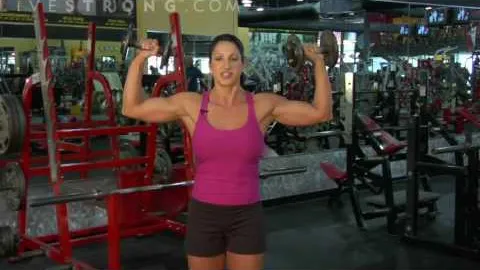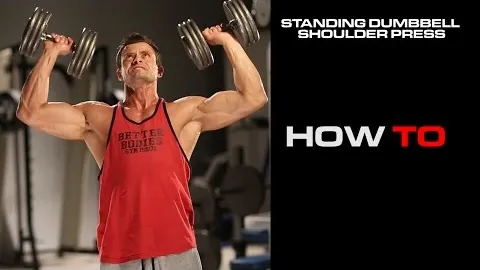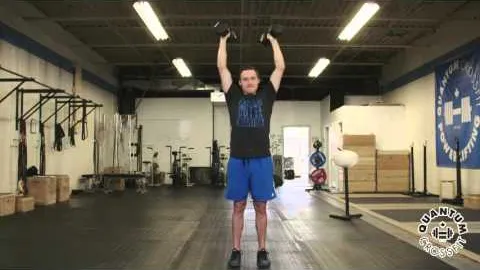





If you're looking to add size and strength to your shoulders, the standing dumbbell shoulder press is a highly effective exercise that should be a staple in your workout routine. This compound movement targets your deltoid muscles, as well as the trapezius and triceps, helping you build a well-rounded upper body.
Muscle Activation: The standing dumbbell shoulder press activates multiple muscle groups, including the anterior deltoids, lateral deltoids, and triceps. This exercise allows you to lift heavier weights, resulting in increased muscle activation and growth.
Functional Strength: Standing shoulder presses mimic real-life movements, such as lifting heavy objects overhead. By training with this exercise, you improve your upper body strength, making everyday tasks easier to complete.
Balanced Muscle Development: The standing dumbbell shoulder press ensures balanced muscle development in your shoulders. It engages both the anterior and lateral deltoids equally, helping you achieve well-rounded, symmetrical shoulders.
Core Engagement: To stabilize the weights during the standing dumbbell shoulder press, your core muscles have to work to keep your body balanced and stable. This leads to improved core strength and stability.
Starting Position: Stand with your feet shoulder-width apart, holding a dumbbell in each hand at shoulder level. Your palms should be facing forward, and your elbows should be bent at a 90-degree angle.
Execution: Exhale as you extend your arms overhead, fully extending your elbows without locking them out. Keep your core engaged to maintain a stable posture throughout the movement. Inhale as you lower the dumbbells back down to the starting position.
Key Tips:
Using Excessive Weight: When performing the standing dumbbell shoulder press, it's crucial to choose a weight that allows you to maintain proper form throughout the exercise. Avoid using excessively heavy weights that compromise your stability and increase the risk of injury.
Lack of Full Range of Motion: Ensure that you fully extend your arms overhead during each repetition. Failing to do so limits the effectiveness of the exercise and can lead to muscle imbalances.
Poor Posture: Maintain proper posture throughout the exercise by keeping your chest up, shoulders back, and core engaged. Avoid leaning backward or hunching forward, as this places unnecessary strain on your spine.
Neglecting Warm-up: Before performing the standing dumbbell shoulder press, it's essential to warm up your shoulders and upper body with dynamic stretches and mobility exercises. This prepares your muscles for the workout and reduces the risk of injury.
Here's a sample workout routine that incorporates the standing dumbbell shoulder press:
Warm-up: Perform 5-10 minutes of light cardio followed by shoulder mobility exercises.
Exercise 1: Standing Dumbbell Shoulder Press - 3 sets of 8-10 reps.
Exercise 2: Lateral Raises - 3 sets of 10-12 reps.
Exercise 3: Face Pulls - 3 sets of 12-15 reps.
Exercise 4: Bent-Over Reverse Flyes - 3 sets of 10-12 reps.
When performing the standing dumbbell shoulder press, it's important to prioritize safety. Here are a few tips to keep in mind:
Use proper form and technique to avoid strain or injury.
Start with lighter weights and gradually increase the load as your strength improves.
If you have any pre-existing shoulder or upper body injuries, consult with a healthcare professional before attempting the exercise.
If you experience any discomfort or pain during the exercise, stop immediately and seek guidance from a qualified fitness professional or healthcare provider.
The standing dumbbell shoulder press is an effective exercise for building strong and well-developed shoulders. By incorporating this compound movement into your workout routine, you can enhance muscle activation, improve functional strength, and achieve balanced muscle development. Remember to prioritize proper form, warm-up adequately, and gradually progress your weights for optimal results. Happy lifting!
If you're looking for a gym, fitness club or yoga studio, you've come to the right place.
You can find information about gyms in your area. Browse catalog of gyms and find gyms with classes which are you looking for.
On gym page you can find simple information like address, phone or website. You can find list of available classes. You can check availability of personal training or small group classes. On place page you can also see information about open hours.
You can find gyms near you with amenities, courts, studios and equipments.
Use our map to find gym at your city or district.
In Gym Navigator you can find list of exercises with movies for many body parts.
You can browse exercises catalog and find exercises the best of you.
You can also find exercises grouped into workout plans, which you can use to improve you body. Each routine show you exercises one by one and give you possibility to count you progress and count down rest time.